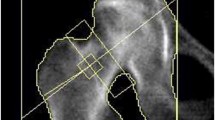Abstract
Objective
To evaluate the reproducibility of imaging and analysis for bone mineral density (BMD) determination using digital computer-assisted X-ray radiogrammetry (DXR; Pronosco X-posure, version V.2, Sectra Pronosco, Denmark); to verify potential factors that influence BMD extrapolation such as tube voltage, film-focus distance (FFD), film quality and brand (Kodak T-MAT-Plus, Konika SRH, Agfa Scopix), imaging technology (conventional, digital), imaging system (Kodak, Agfa) and exposure level (mAs); and to clarify whether DXR analysis based on printouts of digital images is comparable to analysis of conventional images.
Design and patients
The hand of a cadaver was X-rayed using varied parameters: 4–8 mAs, 40–52 kV, 90–130 cm FFD. Radiographs under standardised conditions were performed 10 times using a conventional machine (Philips Super 80 CP) and the printouts of a digital system (Digital Diagnost Philips Optimus) for the analysis of reproducibility. One image was scanned and analysed 10 times additionally for imaging reproducibility.
Results
Reliability error of the system for the imaging process using conventional radiographs-rays was 0.49% (standard conditions: 6 mAs, 40 kV, 1 m FFD), using printouts of digital images was 2.89% (4 mAs, 42 kV, 1 m FFD) and regarding the analysis process was 0.22%. BMD calculation is not affected by alterations in FFD (precision error 1.21%), mAs (0.83%) or film quality/brand (0.38%), but differs significantly depending on tube voltage (2.70%). The system was not able to analyse conventional images with tube voltages of 49/52 kV.
Conclusion
DXR technology is stable with most of the tested parameters. Normative data should exclusively be used for calculations using similar tube voltage or correction factors. All other parameters had no significant influence on the BMD calculation. Reproducibility is high. For technical reasons it is not recommended to use the printouts of digital images for BMD determination.


Similar content being viewed by others
References
Barnett E, Nordin B. The radiological diagnosis of osteoporosis: a new approach. Clin Radiol 1960; 11:166–174.
Virtama P, Mahonen H. Thickness of the cortical layer as an estimate of mineral content of human finger bones. Br J Radiol 1960; 6:60–62.
Wishart JM, Horowitz M, Bochner M, Need AG, Nordin BEC. Relationship between metacarpal morphometry, forearm and vertebral bone density and fractures in postmenopausal women. Br J Radiol 1993; 66:435–440.
Rosholm A, Hylsdrup L, Baeksgaard L, Grunkin M, Thodberg HH. Estimation of bone mineral density by digital X-ray radiogrammetry: theoretical background and clinical testing. Osteoporosis Int 2001; 12:961–969.
Hardin DS, Sy JP. Effects of growth hormone treatment in children with cystic fibrosis: the National Cooperative Growth Study experience. J Pediatr 1997; 131:65–69.
Black DM, Palermo L, Sorensen T, et al. A normative reference database study for the Pronosco X-posure radiogrammetry system. J Clin Densitom 2001; 4:5-12.
Anon. EXPO/DK-04: a clinical study to establish a normative reference database for the Pronosco X-posure system for Scandinavian Caucasian women. Clinical report V.2 20-11-2000
Wüster C, Wenzler M, Kappes J, Rehm C, Gühring T, Arnbjerg C. Digital X-ray radiogrammetry as a clinical method for estimating bone mineral density: a German reference database. J Bone Miner Res 2000; 15:298.
Maffei L, Venarotti H, Treviso J, Sorensen TK, Nissen D. Digital X-ray radiogrammetry: a Hispanic normative reference database for the Pronosco X-posure system. J Bone Miner Res 2000; 15:304.
Yan J, Li M, Zhonhou L, et al. Normal values of forearm bone BMD and incidence of primary osteoporosis in Chinese women. Chinese J Osteoporos 2000; 6:30–32.
Anon. XPO/TECH-016: reproducibility study for X-posure V.2: conventional image capture. Technical report 24-7-2000.
Malich A, Azhari T, Boehm T, Fleck M, Kaiser WA. Reproducibility of a commercially available computer aided detection (CAD) system. Eur J Radiol 2000; 36:170–174.
Glastre C, Braillon P, David L, Cochat P, Meunier PJ, Delmas PD. Measurement of bone mineral content of the lumbar spine by dual energy X-ray absorptiometry in normal children: correlations with growth parameters. J Clin Endocrinol Metab 1990; 70:1330–1333.
Njeh CF, Fuerst T, Hans D, Blake GM, Genant HK. Radiation exposure in bone mineral density assessment. Appl Radiat Isot 1999; 50:215–236.
Wünsche K, Wünsche B, Fähnrich H, et al. Ultrasound bone densitometry of the os calcis in children and adolescents. Calcif Tissue Int 2000; 67:349–355.
Malich A, Mainz J, John S, Böttcher K, Vogt S, Kaiser WA. Ultrasound based bone densitometry of the os calcis measured on asthmatic children using regional normative data. Eur Radiol 2002; 12(Suppl 1):284.
Helboe AB, Juul K, Rosholm A, Andersen PB, Bjarnason NH. High short-term in-vivo precision of the Pronosco X-posure System on hand X-rays. J Bone Miner Soc 2001; 28(Suppl):335.
Malich A, Freesmeyer MG, Mentzel HJ, et al. Normative values of bone parameters of children and adolescents using digital computer-assisted radiogrammetry (DXR). J Clin Densitom 2003; 6:103–111.
Felsenberg D, Gowin W, Diessel E, Armbrust S, Mews J. Recent developments in DXA. Quality of new DXA/MXA-devices to densitometry and morphometry. Eur J Radiol 1995; 20:179–184.
Boonen S, Cheng X, Nicholson PH, Verbeke G, Broos P, Dequeker J. The accuracy of peripheral skeletal assessment at the radius in estimating femoral bone density as measured by dual-energy X-ray absorptiometry: a comparative study of single-photon absorptiometry and computed tomography. J Intern Med 1997; 242:323–328.
Nordin BEC. Calcium, phosphate and magnesium metabolism. In: Clinical physiology and diagnostic procedures. Edinburgh: Churchill Livingstone, 1976:391–397, 512–516, 570–572.
Author information
Authors and Affiliations
Corresponding author
Rights and permissions
About this article
Cite this article
Malich, A., Boettcher, J., Pfeil, A. et al. The impact of technical conditions of X-ray imaging on reproducibility and precision of digital computer-assisted X-ray radiogrammetry (DXR). Skeletal Radiol 33, 698–703 (2004). https://doi.org/10.1007/s00256-004-0861-z
Received:
Revised:
Accepted:
Published:
Issue Date:
DOI: https://doi.org/10.1007/s00256-004-0861-z




